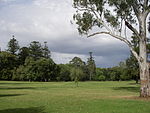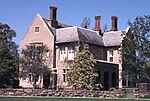War Memorial Drive
1919 establishments in AustraliaAdelaide stubsRoads in AdelaideUse Australian English from June 2021

War Memorial Drive is a connecting road in the South Australian capital of Adelaide. It starts from Bundeys Road near Princess Highway, runs in a western direction following the River Torrens, past the Adelaide Zoo, Adelaide University, Adelaide Oval and past Bonython Park into North Adelaide. Along the road, there are numerous statues of significant Australians and war heroes. The drive was dedicated and named after the heroes and victims of World War I.
Excerpt from the Wikipedia article War Memorial Drive (License: CC BY-SA 3.0, Authors, Images).War Memorial Drive
War Memorial Drive, Adelaide North Adelaide
Geographical coordinates (GPS) Address Nearby Places Show on map
Geographical coordinates (GPS)
| Latitude | Longitude |
|---|---|
| N -34.909053541257 ° | E 138.61154881622 ° |
Address
War Memorial Drive
War Memorial Drive
5006 Adelaide, North Adelaide
South Australia, Australia
Open on Google Maps








